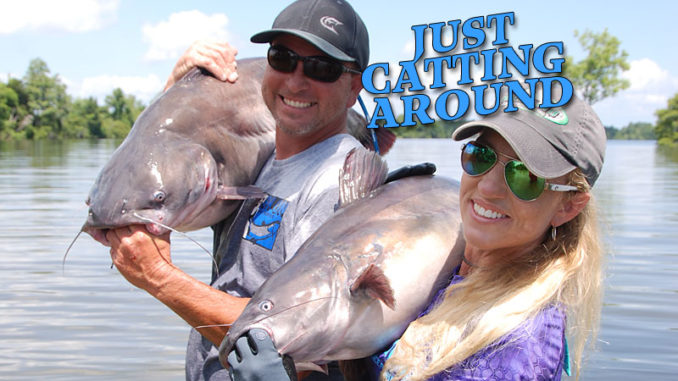
Keep track of catfish movements
Paul Blackwell will be the first to admit that fishing for blue catfish can be tough on any lake across the Carolinas during the prespawn and spawn. But he is also the first to tell you that good catches of trophy sized blues are a real possibility if you pay attention to daily movements of the fish.
“It’s all about looking for their daily pattern,” said Blackwell. “You’ve got to be versatile. Let the catfish show you what they want.”
Blackwell, who runs Fish-On Guide Service on Lake Moultrie, one of South Carolina’s two Santee Cooper lakes, starts his summer days anchored from daylight until the sun gets up, roughly 8 a.m. He’s looking for blue catfish that have moved into the shallows overnight to feed. He’s usually anchored in the back of a creek or ditch, looking to catch a fish or two on that first pass back out to open water.
“After that first stop, it’s time to drop the trolling motor and start pulling baits. The idea is to stay between the catfish and the baitfish,” he said.

The tactic is often referred to as drifting. But Blackwell only goes with the wind on windy days when he can’t go against it with his trolling motor. His typical setup is six heavy action rods rigged with his own variation of the tried-and-true Santee drift rig.
Trolling offers more control than drifting
“I run two rods with a 2-foot leader between a 2-ounce, Dirty South drifting weight and the 5/0 to 8/0 circle hook,” he said. “Then, I’m going to run two more rods with a 2 1/2-foot leader. And the final two rods will have a 3-foot leader between the weight and the hook.”
Blackwell rigs a 3-inch pegged float between the weight and the hook. He also rigs a small Versa-rattle between the cork and hook. To spread his lines out while pulling them behind his boat, he uses planer boards on at least the four outer lines.
“I don’t drift because it’s too hard to control where I’m fishing just going with the wind,” he said. “I use the trolling motor so I can hit my specific marks: contour lines, humps and the edges of flats. I’m a shallow-water fisherman. Everyone knows that. I’m going to be in less than 20 feet of water the whole time.”
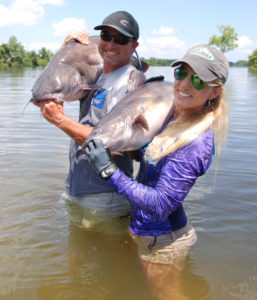
Blackwell said in the early summer, blue catfish start to scatter out during the daytime. It’s a prespawn pattern as catfish begin searching for locations to spawn. Because the fish are spread out, it can make fishing more difficult. That’s why he wants to cover as much productive water as he can in a day’s fishing.
Blackwell believes that areas holding a lot of baitfish will only produce smaller blues, 20 pounds or less. For trophy fish, he’s had better experience with areas that hold smaller pods of bait that are dispersed over a 2- to 5-acre area.
Look for holding areas to find catfish
“I don’t look for fish on the graph when I’m deciding where to fish,” he said. “To me, how the bait is reacting will tell me what I need to know about the catfish. Occasionally, I’ll mark a big fish on the graph. But that just tells me I’m doing the right thing by following the bait ahead of the catfish.”
With his boat between the bait and the catfish, Blackwell starts looking for places the blue catfish are likely to pick as holding areas: humps, channel edges, drop-offs, stumps or the edge of a larger flat. That’s where he’s going to drag his baits.
Blackwell said white perch is, hands-down, his best summer bait. He cuts them into two different pieces to tempt the catfish into taking the bait.
“I have two main cuts,” he said. “One is what I call a ‘catfish sandwich’, and the other is what I call a ‘double meat sandwich.’”
The sandwich cut removes one filet of any sized white perch, then cuts through the backbone and removes the bone from the carcass. The result is the head with one fillet left attached.
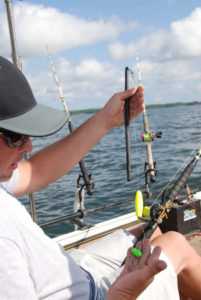
Catch-and-release is important on trophy cats
The double-meat sandwich is a perch with the backbone removed, leaving two fillets attached to the head that easily flap in the current as the boat moves.
“I really like the looks of the bait moving through the water,” he said. “It’s not stiff; it flaps and waves in the water, and it puts out a lot of scent.”
Although Lake Moultrie is his home base, Blackwell said this is the way he would fish on any lake in either Carolina.
“I’m in the right areas. I’m in the right water depth, and I’m between the bait and the catfish,” he said. “Sooner or later, that bait will connect with a trophy blue catfish, then it’s ‘Fish on!’”
Blackwell’s final thought is to urge catfish anglers to release these big catfish, especially right before the spawning season. He’s not opposed to taking plenty of photos to preserve the memories and has on occasion even been known to get in the water to see a big fish off to make sure it survives to fight another day.
Fishing third shift for flatheads
Everything Paul Blackwell does to catch blue catfish this month goes right out the window when he’s fishing for flathead catfish. His strategy, tactics, baits and even his mindset is exactly opposite when he’s looking for big, yellow catfish.
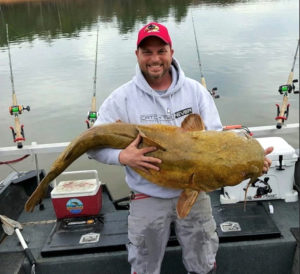
“I fish entirely at night when I’m after flatheads,” he said. “I’m also going to spot-fish for them. I’m anchoring up in an area I feel like they’ll be feeding. And I’m going to stay put a while.”
Blackwell advises that flatheads, especially on his home lake, Lake Moultrie, are very territorial. Based on his experience and by reviewing topo maps of the lake’s floor, he’s going to zone in on what he refers to as good “home spots.”
“I start fishing about an hour after dark. And I’m going to go anchor in a flathead’s home area,” he said. “If you are looking at a lake map, that’s going to be between a good stump or logjam and a shallow area where he will be feeding at night.”
Be patient for flathead catfish
During the summer, flatheads key on bream beds for feeding. If a creek channel, ditch, culvert or other pathway leads from heavy cover to a shallow flat where you would be likely to find bream spawning, it’s probably a decent bet to hold a big flathead catfish.
Blackwell’s typical setup is six Big Cat Fever rods fan-cast around his boat. He likes to fish around wood, rock, concrete or other big pieces of cover that provide a holding area on one side and a buffet of live bait on the other. He will anchor the boat at both ends and set up between the two, right on the travel corridor.
Blackwell will commit an hour-and-a-half to his initial spot, again usually starting around 9 p.m. He’ll go from there to another similar setup.
“You can usually find these areas in the backs of creeks,” he said. “Look for ditches and then back out and look for cover, and you’re probably in a decent spot.”
That’s how he works the entire third shift. Each spot gets between an hour to 90 minutes before he’s on to the next one.
DESTINATION INFORMATION
HOW TO GET THERE — Lake Moultrie is north of I-26 and east of I-95, between Charleston and Columbia. The two interstates provide access to fishing camps and boat ramps. For complete details visit www.santeecoopercountry.org.
BEST TECHNIQUES — At first light, anchor and fish cut white perch on Santee rigs for blue catfish, targeting fish around ditches leading from shallow water back to deep water. Later in the day, drift and target channel edges, humps, dropoffs, stumps and channel edges. Fish at night for flatheads on the edges of shallow flats where bream beds are found.
FISHING INFO/GUIDES — Paul Blackwell, Fish-On Guide Service, 864-202-3095, www.fish-onguideservicellc.com; Bobby Winters, Bob’s Guide Service Encore, 843-753-3343, www.bobsguideserviceencore.com. See also Guides & Charters in Classifieds.
ACCOMMODATIONS — Blacks Camp, 843-753-2231, www.blackscamp.com; Santee Cooper Country, 803-854-2131, www.fishsanteecoopercountry.com.
MAPS — Kingfisher Maps, 800-326-0257, www.kfmaps.com.



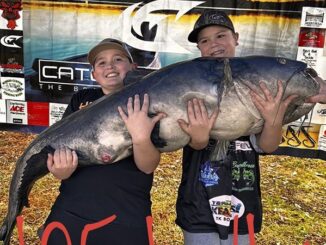

Be the first to comment